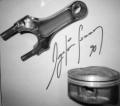
Kaz,
I sell the gasket maker you refer to, and as you stated, the right product is very important. There are three main products out there; acetoxy, oxime and elastomeric. The cheap factor ones are usually acetoxy, it is old tech and not recommended for modern engines. They can cause corrosion problems and aren't always oil resistant.
The oxime product is good. It is oil resistant, non corrosive, sensor safe and has a shorter curing time.
Elastomeric is the best. It cures even faster and is stiffer than the other products.
In summary, avoid acetoxy. Oxime and elastomeric are both great.
Here are some recommendations;
35044 Permatex "the right stuff" 158ml (pressurised container) (elastomeric
35134 Permatex ultra grey 80ml (oxime)
Innotec easy gasket 275ml. (Similar to elastomeric)
I am Godzilla, you are Japan!




 Reply With Quote
Reply With Quote

 I wouldn't have thought of using the liquid gasket, but it seems a neat solution!
I wouldn't have thought of using the liquid gasket, but it seems a neat solution!
